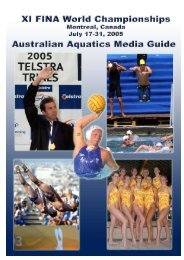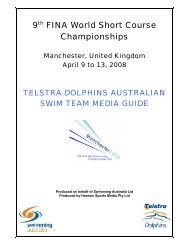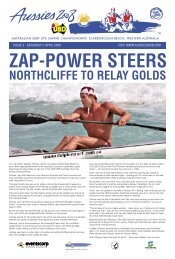Melbourne, Australia March 17- April 1, 2007 - Hanson Media Group
Melbourne, Australia March 17- April 1, 2007 - Hanson Media Group
Melbourne, Australia March 17- April 1, 2007 - Hanson Media Group
Create successful ePaper yourself
Turn your PDF publications into a flip-book with our unique Google optimized e-Paper software.
<strong>Australia</strong>n Aquatics <strong>Media</strong> Guide - XII FINA World Swimming Championships – <strong>Melbourne</strong> <strong>March</strong> <strong>17</strong> – <strong>April</strong> 1, <strong>2007</strong> © HSM<br />
Ten Athletes have been named in the team events but eight will be named. The coach has the discretion under<br />
Fina rules to name the eighth (8th) swimmer up to 2 hours prior to the routine being swum, provided that the<br />
swimmer is already listed on the entry form. (FINA SS 13.2.1)<br />
A BRIEF HISTORY<br />
An aquatic version of gymnastics, Synchronised swimming was popularized in the 1920s. After being<br />
introduced as a demonstration sport in the 1952, 1956, and 1968 Olympics, Synchronised swimming<br />
made its competition debut in the first world championships, which were held in Belgrade in 1973<br />
before becoming an official Olympic event in the 1984 Los Angeles Olympic Games. From then on,<br />
Synchronised swimming is gaining in popularity.<br />
The sport is divided in four different events: solo, duet, team of eight swimmers, and combination. The<br />
first three events are made of two programs, the technical and free. The combination event is a mix of<br />
the solo, duet and team routine.<br />
HOW IT IS DONE<br />
Don’t let their smile fool you… Synchronised swimming athletes must master technique, strength,<br />
power and grace. Moreover, they must perform most of the figures under water, which is why the nose<br />
plug is a must. Underwater speakers also play an important role since they allow swimmers to hear the<br />
music and Synchronise their movements.<br />
EVALUATION<br />
In the technical program, swimmers perform mandatory figures in a precise order. In the free program,<br />
athletes present a choreography at their image, there are no restrictions. Also, whether it is a technical<br />
or free routine, the athletes can chose their swimsuits and music.<br />
Synchronised swimmers are judged on a scale of 10. There are two panels of five judges each; one<br />
focuses on the technical merit while the other evaluates the overall artistic impression. Judges also take<br />
into consideration technique, execution, creativity and ease of performance.









